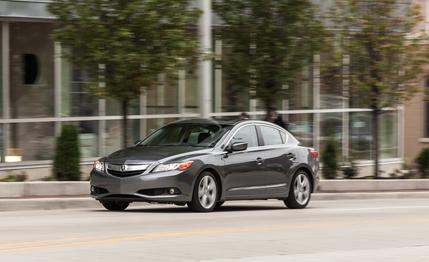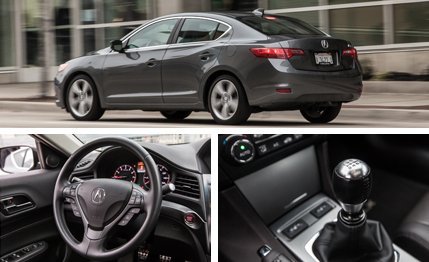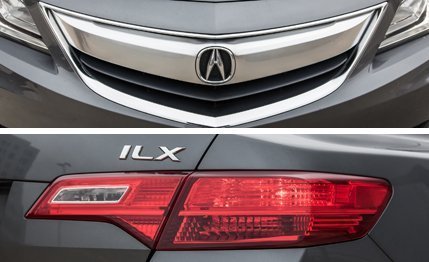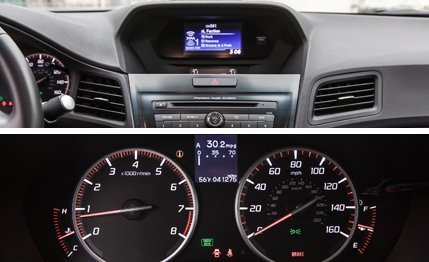
 Long-Term Road Test Wrap-Up
Long-Term Road Test Wrap-Up
Months in Fleet: 17 months
Current Mileage: 40,106 miles
Average Fuel Economy: 28 mpg
Average Range: 356 miles
Service: $620
Normal Wear: $0
Repair: $0
Damage and Destruction: $181
When Acura’s ILX sports sedan arrived for 2013, we harbored few hopes that it would be a new-age Integra. We did figure at least one version would be fun, an expectation that sprung from the existence of the effervescent 201-hp, 2.4-liter four-cylinder and six-speed manual on the powertrain roster. It’s the same pairing as found on Honda’s Civic Si, and we figured that such an ILX would combine the bubbly personality of the Si with the interior comforts that accompany Acura badging. We were right, although that doesn’t tell the whole story.
Zing Zing Zing
In the ILX lineup, the 2.4 is available only with a stick, and not one logbook entry failed to heap praise on the rev-happy four-banger or the smooth-shifting gearbox. We loved popping into the compact sedan for jaunts around Ann Arbor, largely because of this powertrain combo. And, thankfully, that sticky feeling in the transmission we reported in the last update can be chalked up to cold weather—shift feel was as slick as ever once temperatures returned to what Michiganders refer to as mild.


The yin to the ILX’s charming about-town yang is its childish behavior on the freeway. At highway speeds, the car’s short gearing and lack of taller overdrive ratios keeps the 2.4-liter turning well north of 3000 rpm in sixth gear. A number of logbook scribblers admitted to reaching for a taller gear on the interstate, only to discover they were already in sixth. Such engine drone—not to mention the ample volumes of road and wind noise—is awfully unbecoming of a model from a luxury brand, even one touted as a junior sports sedan.


Even when emphasizing the “junior” in junior sports sedan, the ILX never quite lived up to expectations. The Acura’s electric power steering is parking-lot light at initial turn-in but then loads up unnervingly as input is added. Quick changes in direction are met by slow responses from the combination of steering, suspension, and tires, and it’s not long before requests and the car’s reactions are out of sync.
However, the ILX showed improvement in some performance metrics as its stay with us wore on. Braking was markedly better, lopping 18 feet from the initial 70-mph-to-0 stopping distance, down to a respectable 166. This can likely be explained by the wear of the ILX’s Michelin Pilot HX MXM4 all-season tires, whose blocklike tread pattern can squish when fresh, reducing grip levels and stretching braking distances. After 40,000 miles, this rubber wore and subsequently stiffened, yielding significantly improved performance, further evidenced by an increase of 0.02 g in roadholding grip to 0.83.
As for the powertrain, the 0-to-60-mph sprint improved by 0.2 second, to 6.2 seconds, and the quarter-mile time dropped by 0.1 to 14.9 seconds at a speed of 96 mph—1 mph faster than in our initial testing. Fuel economy rose from 27 mpg during the first portion of the ILX’s stay to 28 mpg by the time 40,000 miles rolled around.


The ILX proved to be largely trouble-free, and its five visits to the dealer were relatively gentle on our wallet. Our first trip at 8710 miles included an oil change and tire rotation—as well as a new set of front door latches per a recall—and set us back $71. We returned roughly 5000 miles later to fix a passenger-side front-door lock that went on strike and to diagnose a vibration at speed. The techs found and fixed (under warranty) a loose door-lock connection and discovered a nail in the right rear tire that was also fixed free of charge; all four wheels were balanced, which cost us $74. At 17,435 miles, a scheduled maintenance visit to change the oil and rotate the tires turned up a slightly bent rim and a bubble in one of the tires. The new rubber rang up at $107. We were back again at 26,826 miles for another oil change and tire rotation and to have the cabin and engine air filters replaced. At that point, we complained that the passenger seat wobbled in its tracks but were told it wasn’t anything out of the ordinary. Our final visit (at 36,197 miles) was for a $151 oil change, vehicle inspection, and tire rotation.
Badge for Your Buck
The ILX let us down again once we focused on the “L” word—that’d be luxury. As we’ve lamented in this car's introduction and update, Acura doesn’t offer navigation with the 2.4-liter with manual-transmission combination—inexcusable for a brand fighting to remain relevant in the luxury segment. “When navigation can be had in a Nissan Versa sedan, navigation should be available in an Acura, regardless of which engine is under the hood,” opined one logbook entry. The five-inch infotainment display that did come with our car looked and behaved as if it were a decade old, too.
Perhaps our biggest issue with the Acura ILX is that its most endearing feature—the drivetrain—can be had in a couple of less-expensive Hondas. The cheaper-and-bigger option is the Honda Accord Sport, which utilizes a similar powertrain, albeit detuned by 12 horsepower, while offering more interior space and improved efficiency for $5915 less. Of course, the other car is the Civic Si sedan, which costs $6590 less than the ILX, and for an extra $1500, Honda will even equip your Si with navigation. At $25,005, that’s a relative bargain compared with our $30,095 ILX.


Neither of those Hondas has leather seating, pushbutton start, or dual-zone climate control, the sort of stuff that’s mandatory in the luxury realm, but as our leather-upholstered chairs suffered visible wear and were cited for a lack of support and overall comfort, one could argue that some of the ILX’s luxury trinkets aren’t necessarily up to snuff.
We applaud Acura for being among the first to join the rapidly growing compact luxury-sedan arena, but as in other segments, the brand’s unexciting styling and product-planning missteps are significant handicaps. For the ILX, they’re even more glaring in the face of the new, premium small cars from Audi, Mercedes, and BMW.